If you're like many TrueDelta members, you've decided to buy a compact crossover, but feel overwhelmed by the large number of models to choose from. Jump back 20 years, and only Honda and Toyota offered compact vehicles with car chassis but SUV bodies. But it wasn't long before car buyers realized that these vehicles offered the combination they'd been wanting: the elevated seating and practicality of an SUV with the ride and handling of a car. Sales grew and grew. In response nearly every brand started offering a compact crossover.
How might a model distinguish itself within this crowded field? If you're GMC, with a "professional grade" image to justify and a Chevrolet sibling to cover the bland middle of the market, you offer chunkier styling and--with the redesigned-for-2018 second-generation model--the option of a diesel engine, a class first in North America.
The problem with firsts, from a review standpoint: what to compare them to? In the wake of the VW diesel fiasco Audi, BMW, and Mercedes no longer offer diesels in their compact crossovers. Jaguar does offer its F-Pace with a diesel engine. But comparing the GMC to a sleek, $13,000-more-expensive Jaguar strikes me as silly.
This leaves the Toyota RAV4 Hybrid (compared to the Kia Niro not terribly long ago) as the next closest match. Though not a diesel, the end is the same: better fuel economy. But, with a redesigned 2019 around the corner, the current RAV4 is in its final months, so I'd like another point of comparison.
For those seeking a rugged aesthetic, the Jeep Cherokee most closely competes with the GMC Terrain. But, like the RAV4, the Cherokee will also be updated for 2019.
Moving a bit lower in the Jeep line, we have the half-size-smaller recently redesigned Compass, which I have been wanting to check out. So GMC Terrain vs. Jeep Compass it is. Which most deserves to break free of the pack?
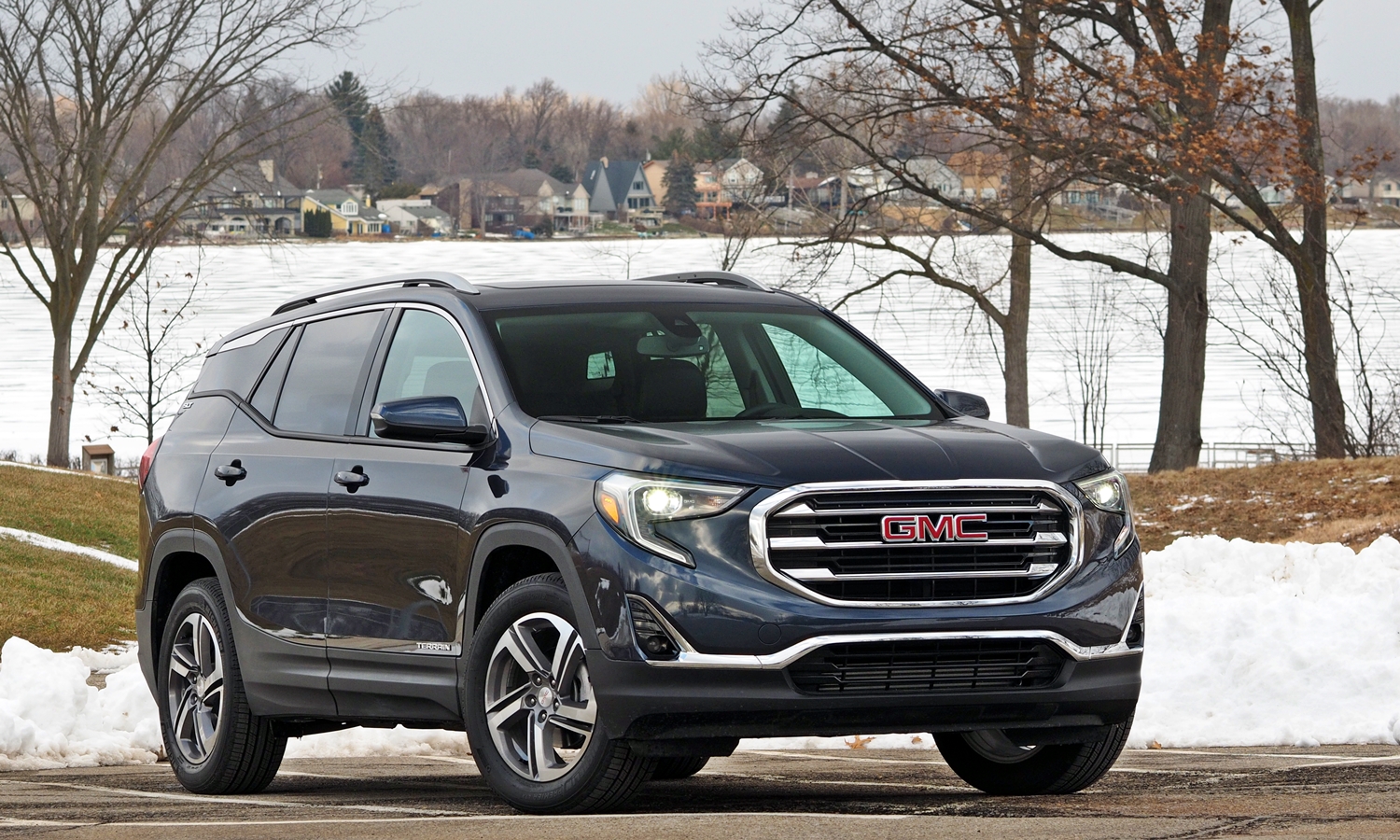
Chunkier, truckier styling than the related Chevrolet Equinox. more Terrain photos
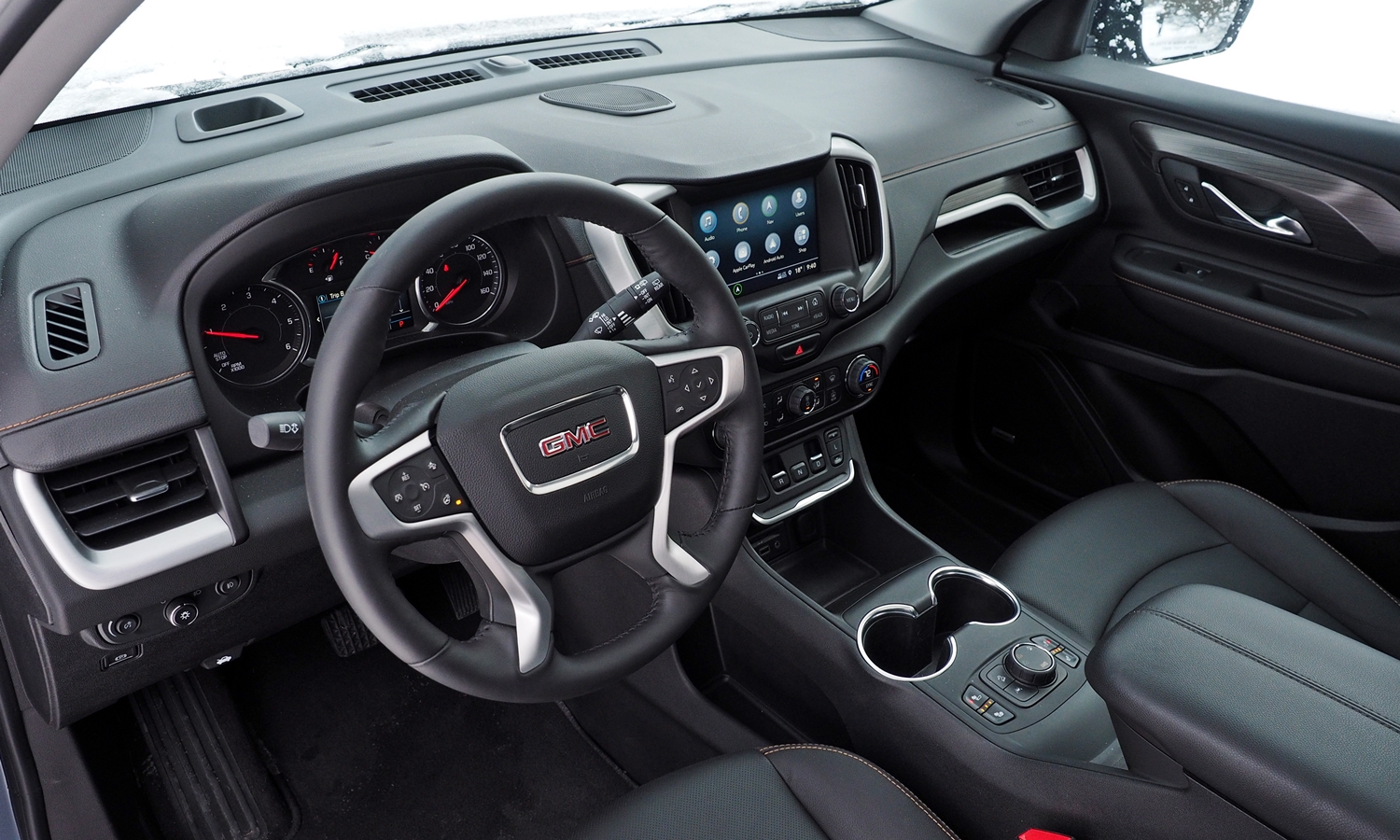
Good materials for the price. Rearward location of the seat heater switches. Where's the shifter?
| |
Compared to the Compass |
| Fuel economy |
 Better
Worse
Better
Worse
|
Diesel engines burn far cleaner than they used to. But even the best retain disadvantages. Diesel fuel is nasty, greasy stuff, with a feel closer to motor oil than gasoline. Spill any on your hands, clothes, shoes, or car while filling up and it doesn't evaporate away like gas does. Also, the GMC Terrain's exhaust stinks, especially when its engine is cold. You might want to have the fresh air vent closed if you'll be reversing after starting up the vehicle.
Given these disadvantages, a diesel better deliver strong EPA fuel economy ratings, and this four-wheel-drive GMC does: 28 mpg city, 38 mpg highway. (Dropping 4WD adds another mpg to the highway rating.) The Jaguar F-Pace diesel lags, with 26/33, as might be expected given its larger (2.0- vs. 1.6-liter), considerably more powerful (180- vs. 137-horsepower) engine.
The RAV4 Hybrid is more economical in city driving, with an EPA rating of 34 mpg, but well behind in highway driving, with an EPA rating of 30. This is typical of diesel vs. hybrid comparisons, as hybrids are designed to recoup energy otherwise burned off by the brakes and thus deliver the largest bump in city driving.
Even more than with most vehicles I test, the Terrain diesel's real-world fuel economy varied dramatically based on driving style and conditions. In the suburbs, trip computer averages ranged from 25 to 40 mpg, with most results around 30. On the highway, the trip computer reported low 40s in one direction, then low 30s in the other (on two different days, with no especially strong wind on either).
In a suburban test drive of the Toyota RAV4 Hybrid, the highest trip computer average I could achieve was 38 mpg. Quite good for a compact crossover, and nearly even with the best suburban average I observed in the Terrain diesel.
Compared to a Terrain with the standard gas engine, the diesel rates four mpg high in the city and ten mpg higher on the highway.
Compared to the Terrain with its base gasoline engine, the Jeep Compass rates lower in the city (22 vs. 24 mpg) but higher on the highway (30 vs. 28 mpg), so gas-to-gas they're about even.
| Quietness |
 Better
Worse
Better
Worse
|
If the GMC Terrain isn't the quietest vehicle in its class, it's close. But with a diesel? Diesels used to have a rep for being noisy and rough. The Terrain's smallish diesel engine only sounds clattery and feels rough at idle, especially when cold. Once up and running the oil-burner doesn't call attention to itself.
The Jeep Compass is nearly as quiet as the Terrain. When accelerating, the buzzy four-cylinder engine assaults the ears worse than the Terrain's diesel does. But it's still not as bad as the engine in the new Honda CR-V.
Toyota improved the quietness and smoothness of the RAV4 with a 2016 update. But they haven't been able to do anything about the hybrid's oddly non-linear sound and feel when accelerating, a by-product of how its gasoline engine and electric motors are yoked via a planetary gearset. This wouldn't be an issue if the gas engine was nearly silent, but it isn't. In general the RAV4 doesn't feel or sound as refined as the Terrain.
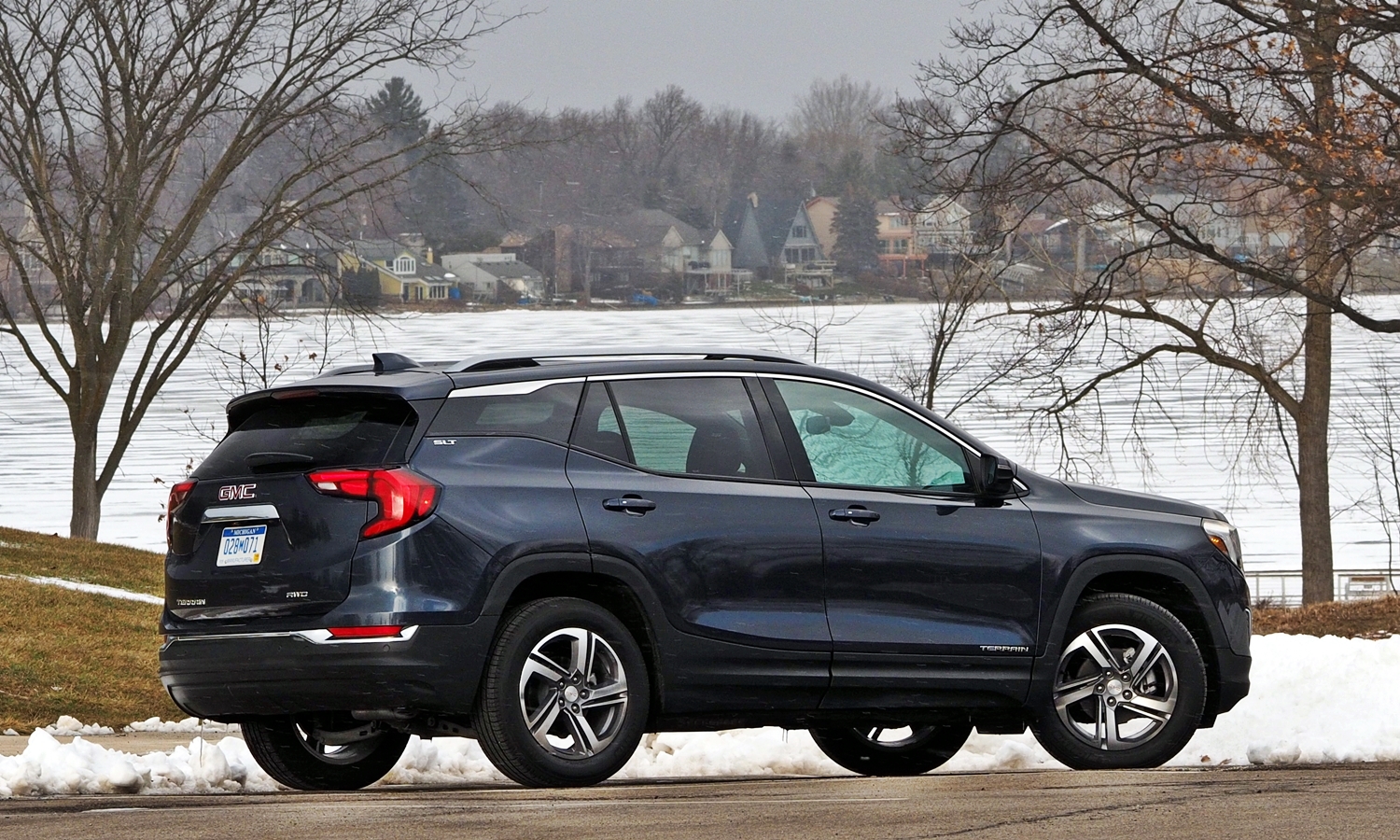
A lot going on in the rear corners of the GMC. Small rear quarter windows--adjust the mirrors well.
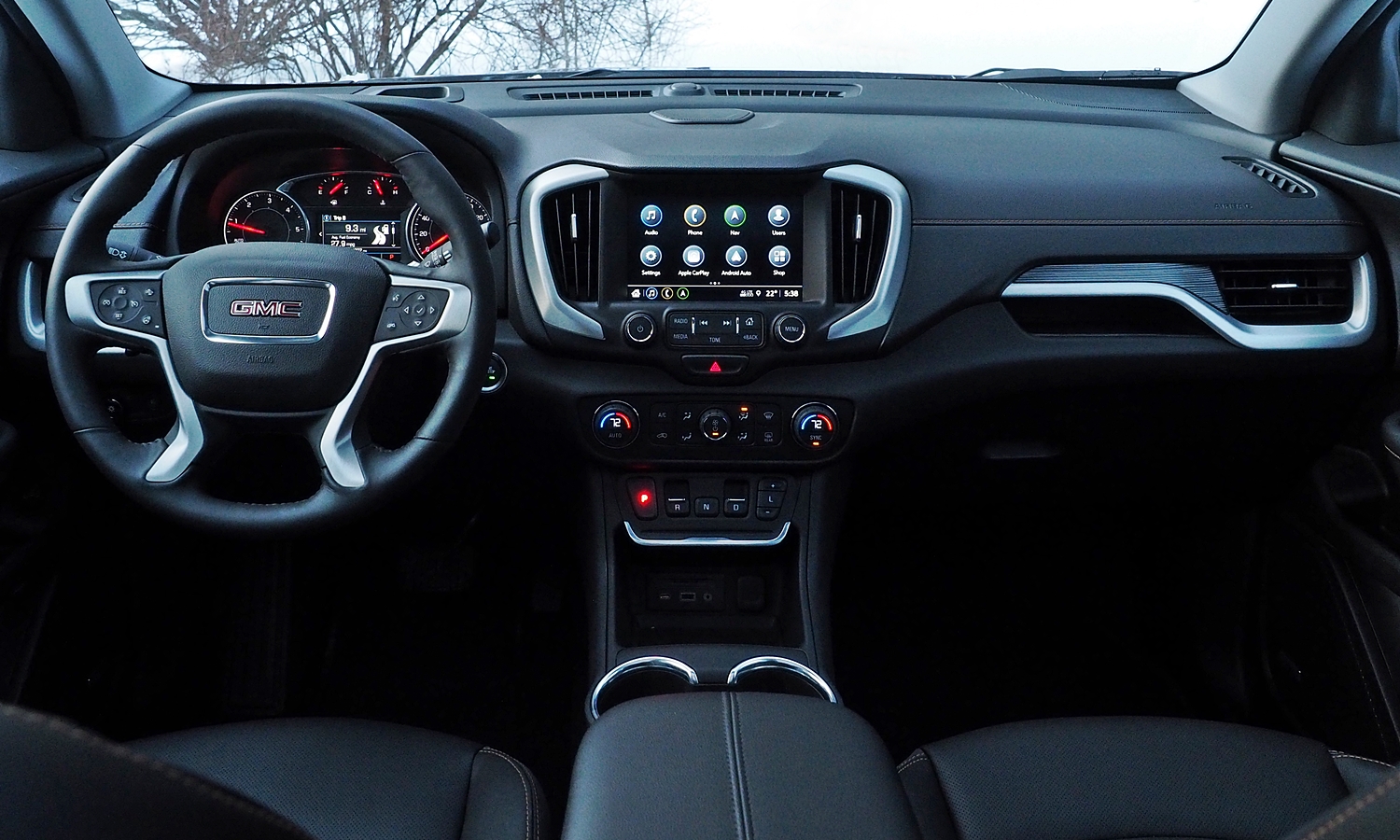
GMC likes chunky silver trim. Have you found the shifter?
| Ride smoothness |
 Better
Worse
Better
Worse
|
The GMC Terrain feels solid and might also be the smoothest-riding vehicle in its class. That said, the 2010-2017 Terrain, with a 5.2-inch-longer wheelbase, might have been steadier still.
The Jeep Compass rides almost as well.
| Front seat support & comfort |
 Better
Worse
Better
Worse
|
See a trend emerging? I found the GMC Terrain's front seats well-contoured, comfortable, and supportive in turns. The front seats in the Compass, though not uncomfortable, didn't fit me as well.
| Rear seat room & comfort |
 Better
Worse
Better
Worse
|
The first-generation GMC Terrain took advantage of a long, 112.5-inch wheelbase to offer exceptional rear legroom--nearly 40 inches of it. On paper, the 2018 Terrain has only a half-inch less combined legroom despite a wheelbase shrink of 5.2 inches (to better align the vehicle with competitors and open up space for the downsized Acadia). In reality, rear legroom seems ample but no longer outstanding. The rear seats in the Honda CR-V and Toyota RAV4 are similarly roomy.
But the Terrain does pull ahead when evaluating rear seat comfort. Its high-mounted rear seat cushion provides better leg support than others. The Compass's rear seat is lower and firmer. The Terrain's rear seat can even recline a little.
Based on their specs, the Jeep is nearly as roomy inside as the GMC. Headroom, shoulder room, and combined legroom specs all differ by less than an inch. In reality, the Jeep's interior feels significantly narrower. And the Jeep Cherokee? All of its interior specs are also within an inch of the Terrain's, though often in the other direction.
Why does Jeep offer two crossovers so close in size? This isn't clear. In terms of specs, they differ most in combined legroom and cargo volume. The Cherokee has 1.3 inches more of the former--good to have, but hardly justification for an additional model--and about ten percent LESS of the latter. How can the larger Jeep have less cargo volume? I suspect that the Compass was measured more creatively, and cannot actually hold as much cargo.
Based on their specs--and I always take cargo volume specs with more than a little salt--the new Terrain can swallow a few more cubic feet of cargo than the Compass (63.3 vs. 59.8) but falls well short of the RAV4 (70.6 in hybrid form, 73.4 otherwise). A Honda CR-V can fit a couple more cubes than the RAV4.
The GMC Terrain and the Jeeps compensate for not having the most spacious cargo areas with front passenger seats that fold forward. If your cargo is long but not wide, one of these is the way to go. Though closely related to the GMC, the Chevrolet Equinox does not offer this feature.
| |
Compared to the Compass |
| Price or payments |
 Better
Worse
Better
Worse
|
When GMC downsized the new Terrain for 2018 they didn't downsize its price, which remains significantly higher than that of competitors.
When both are loaded up, the 2018 Terrain's price is actually $1,820 higher than the 2017's. To be fair, the 2018 includes about $2,700 in additional features. The first-gen Terrain, introduced as a 2010, had fallen behind the curve in the features department--you even had to physically insert a key and twist to start it (the horrors). Factor in the 2018's additional content and it's a better value than the 2017 was.
On top of the Terrain's relatively high price the diesel engine adds another $3,000. The tested Terrain SLT Diesel with all options lists for $42,035. The Terrain is also offered in a lower-priced SLE (from $25,990) and a higher-priced Denali. But the diesel engine isn't available with the latter, so it tops out at $42,285, just a bit higher than the test vehicle.
Load up both a GMC Terrain Diesel and a Toyota RAV4 Hybrid, and the former lists for nearly $6,000 more. About $1,500 can be attributed to additional content on the GMC, leaving a still substantial $4,500 difference.
For other price comparisons it doesn't make sense to include the diesel.
The half-size smaller Jeep Compass checks in about $3,500 lower. Somehow, once feature differences are accounted for, the similarly sized Jeep Cherokee also checks in about $3,500 lower. The larger Jeep starts $1,900 higher, but especially when loaded up additional content nearly and even entirely cancels out the difference.
You might wonder how much more it costs to get the "professional grade" Terrain rather than the (standard grade?) Chevrolet Equinox. When both are equipped with the diesel engine, the least-expensive GMC Terrain lists for $900 more than the least-expensive Chevrolet Equinox, $32,595 vs. $31,695.
| Feature availability |
 Better
Worse
Better
Worse
|
Load both the GMC Terrain and the Chevroelet Equinox up with the diesel engine and a funny thing happens: the Equinox's price advantage increases to $1,480 despite it having over $800 in additional content. How can the Chevrolet offer more features than the GMC when both are equipped with the diesel engine? Well, on the GMC Terrain some features (LED headlights, ventilated front seats, heated rear seats, a wireless charging station, and an around-view camera system) are available only on the Denali, and the diesel engine is not available on the Denali. So you cannot get these features with the diesel on the Terrain. In contrast, Chevrolet does offer the diesel on the Equinox's top trim level.
This quirk aside, far more features are available on the 2018 Terrain than on the 2010-2017 Terrain. Perhaps most noteworthy, you no longer have to remove the key from your pocket to unlock the doors and start the engine, and you can get a heated steering wheel. But at least one feature remains oddly unavailable: you still cannot get adaptive cruise control.
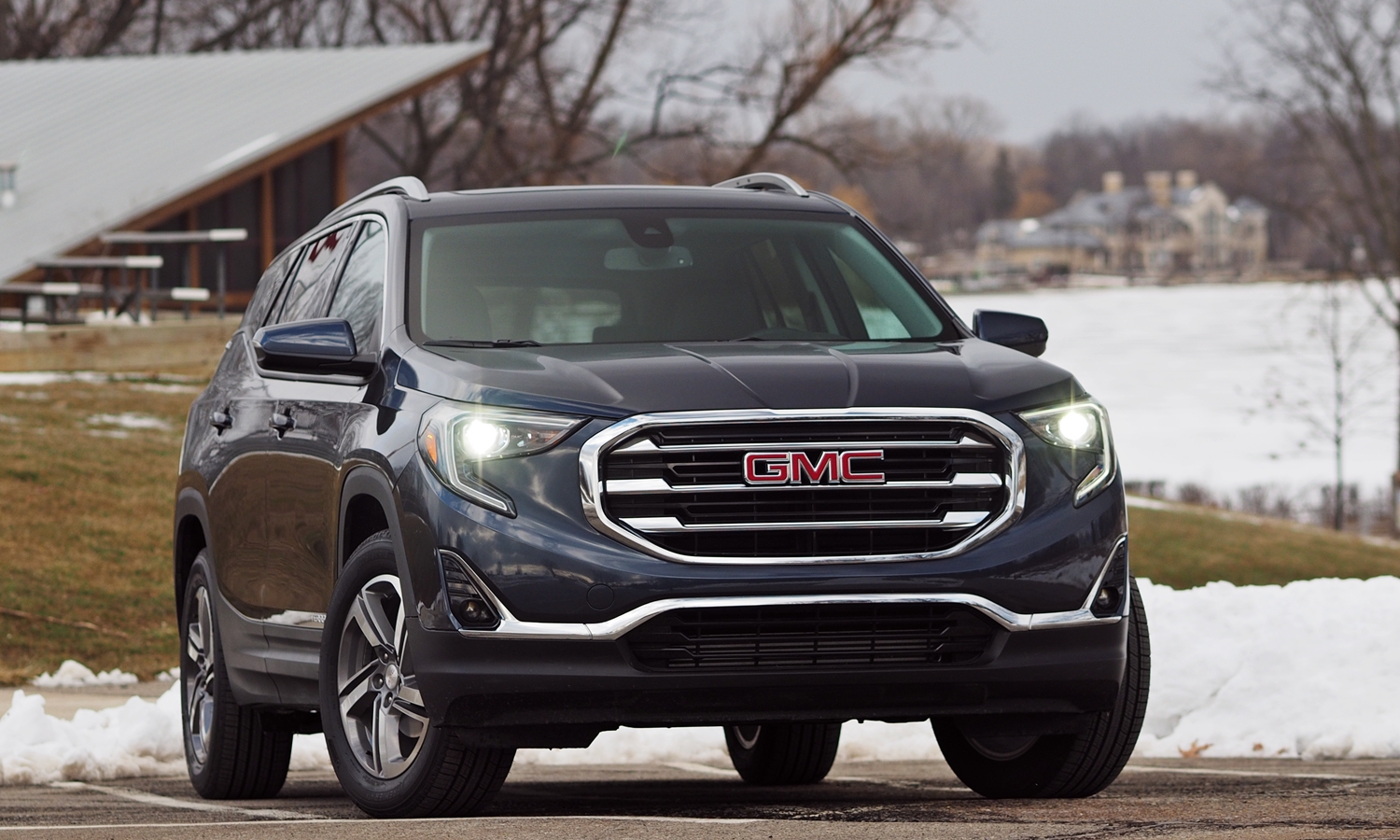
Bold grille typical of GMC. Do you prefer this pic, with a blurred background?
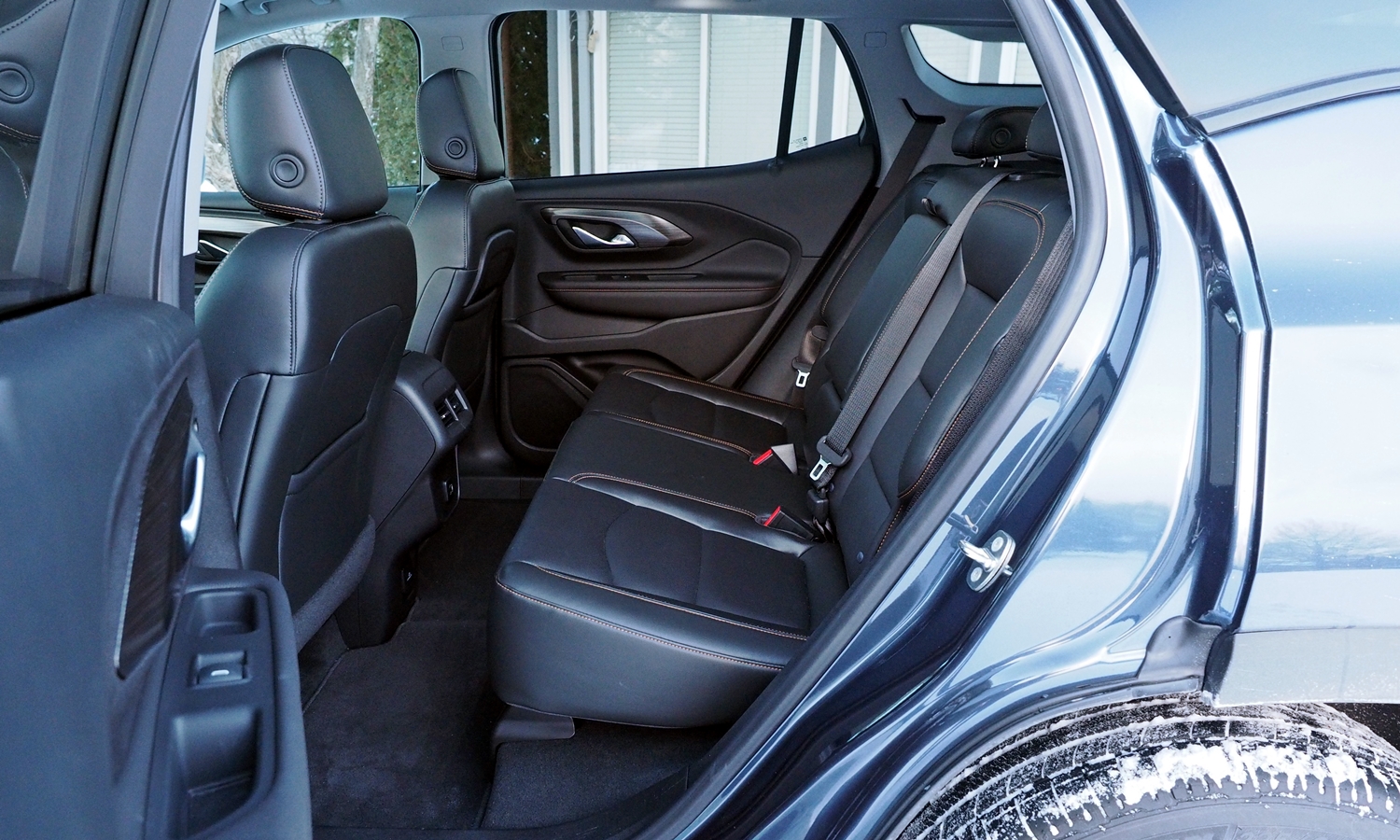
The GMC Terrain's rear seat sits higher off the floor than most. Good for adult comfort.
| Controls and instruments |
 Better
Worse
Better
Worse
|
Auto makers keep trying to reinvent the transmission shifter, allegedly to free up space in the center console. GMC's novel solution, a series of pull switches and push buttons at the base of the center stack, never ceased to annoy me. They're too far away and their operation is far from intuitive. I much prefer a conventional shift lever, as in the related Chevrolet Equinox and in the Jeep.
Another ergonomic sin: the switches for the Terrain's seat heaters are located so far back on the unencumbered center console that they cannot be safely checked while driving. I don't care for how you have to use the touchscreen to turn on the seat heaters in the Jeep, but at least you can view how high they're set without taking your eyes completely off the road.
In both the Terrain and in the Jeep Compass the audio system must be turned on to use any of the infotainment system's features, including nav. You can mute the audio system's volume if you want to drive in silence, but this seems an unnecessarily complication.
| Powertrain performance |
 Better
Worse
Better
Worse
|
Reviewers often praise the low-end torque of diesels, and the 1.6-liter turbo-diesel does out-twist the turbocharged 1.5-liter gas engine by 37 lb-ft (240 vs. 203). But it's still no match for the turbocharged 2.0-liter gas engine's 260 lb-ft.
Note the size of the diesel engine. Nearly every other four-cylinder diesel that has been offered in the US in recent memory has been a 2.0-liter (give or take 100 cc). Previously GM also offered a 264-lb-ft 2.0-liter turbo-diesel, in the Chevrolet Cruze sedan. To me, the 2.0 seemed larger than was necessary in the Cruze, especially if maximum fuel economy was the goal. GM apparently agreed, and replaced the 2.0-liter with the 1.6-liter engine, first in the redesigned Cruze and now in the Equinox and Terrain.
The thing is, this size engine is less adequate in the crossovers than in the lighter sedan. In the Terrain and Equinox a 2.0-liter diesel engine might have been more apt. The best diesel-compact crossover partnership I've driven was the Mercedes-Benz GLK250 with a 201-horsepower 2.1-liter turbo-diesel. In the GMC's defense, its smaller, less powerful engine yields superior fuel economy ratings, 28/38 vs. 24/33. And that said, in my real-world suburban driving the trip computer averages weren't nearly so far apart.
Getting back to performance, the 1.6-liter feels sufficiently strong in nearly all around-town driving, and even somewhat torquey at low speeds. But when more is requested of it, especially at highway speeds, it can't deliver. Like all diesels, the Terrain's 1.6 has a low power peak, its output topping out at 3,750 rpm with 137 horsepower (14 fewer than the old 2.0-liter). The 1.5T gas engine can produce 170 horsepower at 5,600 rpm, while the 2.0T gas engine can produce 252 horsepower--nearly twice as much as the diesel--at 5,500 rpm. (But still well short of the 2017 Terrain's 301-horsepower 3.6-liter V6.) I wasn't impressed with the 1.5T in a Chevrolet Equinox. It got the job done, but never felt quick or responsive. If you want strong acceleration, you want the 2.0T gas engine.
Even in typical around-town driving the diesel feels less responsive than even the smaller gas engine. When summoned, the turbocharger takes a moment or two to spin up. Also worth noting: there's a couple-second delay between hitting the start button and the engine starting up, at least in cold weather (temps were in the 20s).
With its 180-horsepower 2.4-liter engine, the Jeep Compass feels about as energetic as the Terrain with its base gasoline engine. With the Jeep, though, you have no other options.
When pressed, the Toyota RAV4 Hybrid can accelerate significantly more quickly than the Terrain diesel--and more quickly than the regular RAV4--but sounds and feels like it'd rather progress at a more leisurely and more economical pace. The Terrain diesel might be slower, but it never sounds as strained.
| |
Compared to the Compass |
| Handling |
 Better
Worse
Better
Worse
|
As has generally been the case with GM's crossovers, the GMC Terrain doesn't feel agile or sporty. Yet when called upon to corner, the Terrain tackles curves with unexpected precision and control. The capability is there, you just have to go looking for it.
The Jeep Compass feels a half-size smaller, and thus more agile. Its steering feels heftier, but if anything provides less feedback than the Terrain's. When pressed the Jeep doesn't maintain its composure quite as well as the GMC does.
If you're seeking a more engaging compact crossover, but cannot afford a Jaguar or Porsche, then the Mazda CX-5 is the way to go. Really, though, none of the vehicles in the Terrain's class is much fun to drive, so I cannot knock it too much in this area. I'd rather drive either the Terrain or the Compass than the RAV4 or the Honda CR-V.
| Off-road capability |
 Better
Worse
Better
Worse
|
I ventured off-road in none of these vehicles. That said, if you're seeking a compact crossover designed for venturing off the pavement, you want either Jeep in Trailhawk form.
| Interior styling |
 Better
Worse
Better
Worse
|
The new GMC Terrain's interior materials are among the nicest in its class, trailing perhaps only the Mazda CX-5's. The soft-touch instrument panel is embedded with stitching in a contrasting color. While stitching that serves an entirely decorative purpose will rub some people the wrong way, this execution is much better than molding fake stitching into the dash (as Honda has become wont to do). Clunky silver trim, a GMC cue, runs a bit against the otherwise moderately upscale aesthetic. One slightly offputting detail: the infotainment system's obviously hollow knobs feel somewhat cheap.
While I like the Compass interior's red highlights, overall it looks and feels less upscale than the Terrain's. And the Toyota RAV4's interior? In appearance and materials it's far behind the other two.
| Exterior styling |
 Better
Worse
Better
Worse
|
I like where GMC was trying to go with the new Terrain's exterior. While the Chevrolet Equinox has the bland, rounded, car-like lines of a generic crossover, the Terrain has bolder, chunkier, truckier forms. Unfortunately, the proportions on both sibs seem awkward, as if the designers had to work with a package forced on them by the engineers. This is most apparent when viewing them from the side.
With the new Compass, Jeep's designers more successfully and more cleanly executed a similarly brawny appearance. There's less going on at the corners of the Jeep, and this is one of those cases where less is more.
The 2013-2018 Toyota RAV4 has never been at risk of winning a design competition. With the redesigned 2019 they've aimed to out-truck GMC and Jeep. My initial impression was not good, but others really like the new look and I must admit it has been growing on me.
I like where GMC was trying to go with the new Terrain's distinctive exterior styling, but don't think they quite got there. The interior designers did better aesthetically, but not functionally. I'll be surprised if the novel transmission controls at the base of the center stack enjoy a second application.
Compared to other compact crossovers, the second-generation GMC Terrain stands out for solid construction, a smooth, quiet ride, and comfortable seats. Those seeking maximum fuel economy can opt for a diesel engine with EPA ratings of 28 mpg city, 38 mpg highway. But the 137-horsepower diesel can border on sluggish in a nearly two-ton 4WD crossover (thankfully it never sounds strained). The available fix: a 252-horsepower gas engine.
I prefer the styling of the new Jeep Compass. The Jeep in Trailhawk form also has more off-road capability than other compact crossovers, including the Terrain. But in most other areas it's good but not great and falls short of the Terrain. Additional engine options for those seeking either better fuel economy or better performance would be welcome.
GMC felt they could get away with pricing the Terrain well above competitors, including both compact Jeeps. Even the Chevrolet Equinox, which differs mostly in styling, is less expensive. To this already high price the diesel engine adds another $3,000. But if a GMC Terrain diesel delivers the combination of style, fuel economy, comfort, and functionality you've been seeking--and it very well might--don't let the list price scare you away. Factory incentives and dealer discounts could largely compensate, so it's worth checking to see what the actual out-the-door price would be.
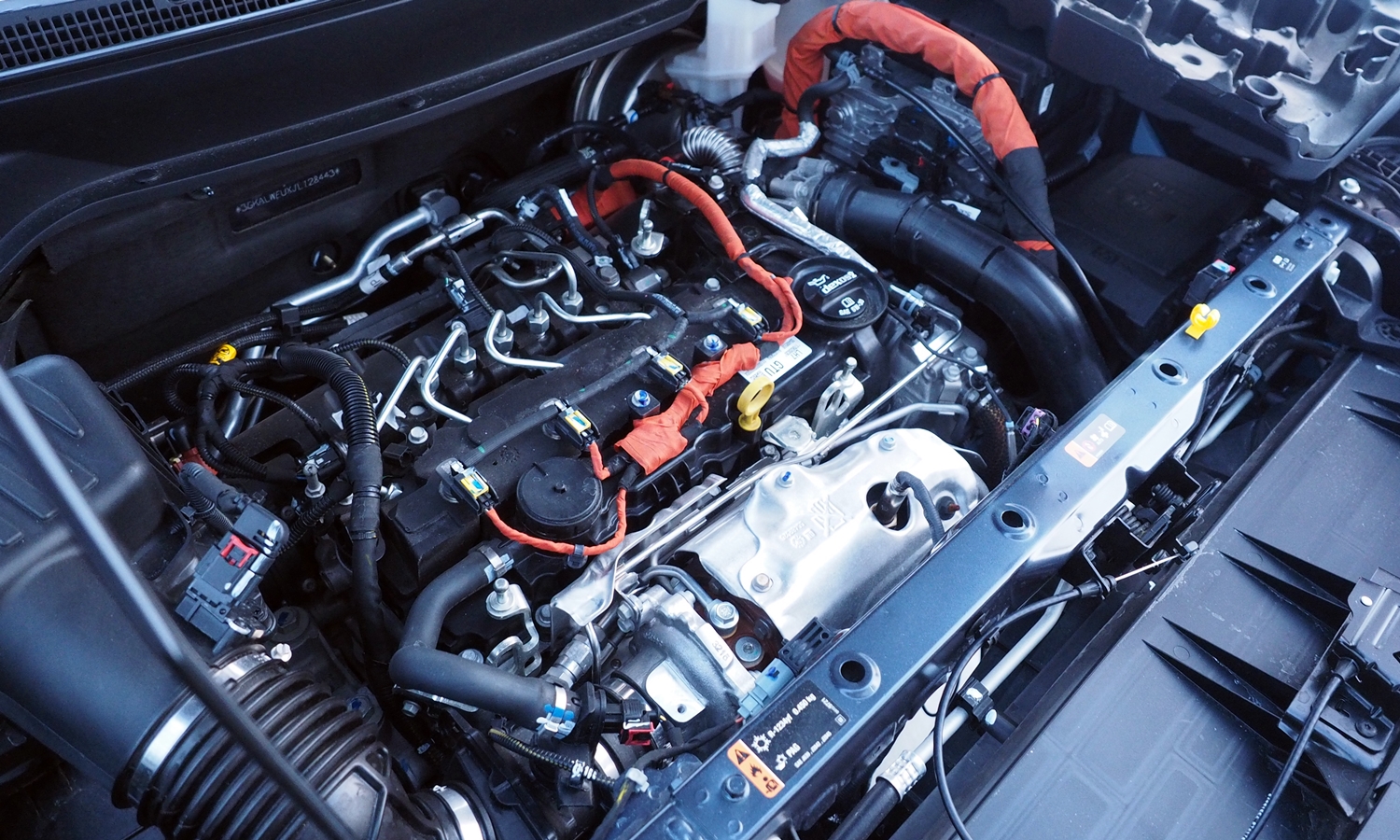
Under the cover. Turbo out in front.
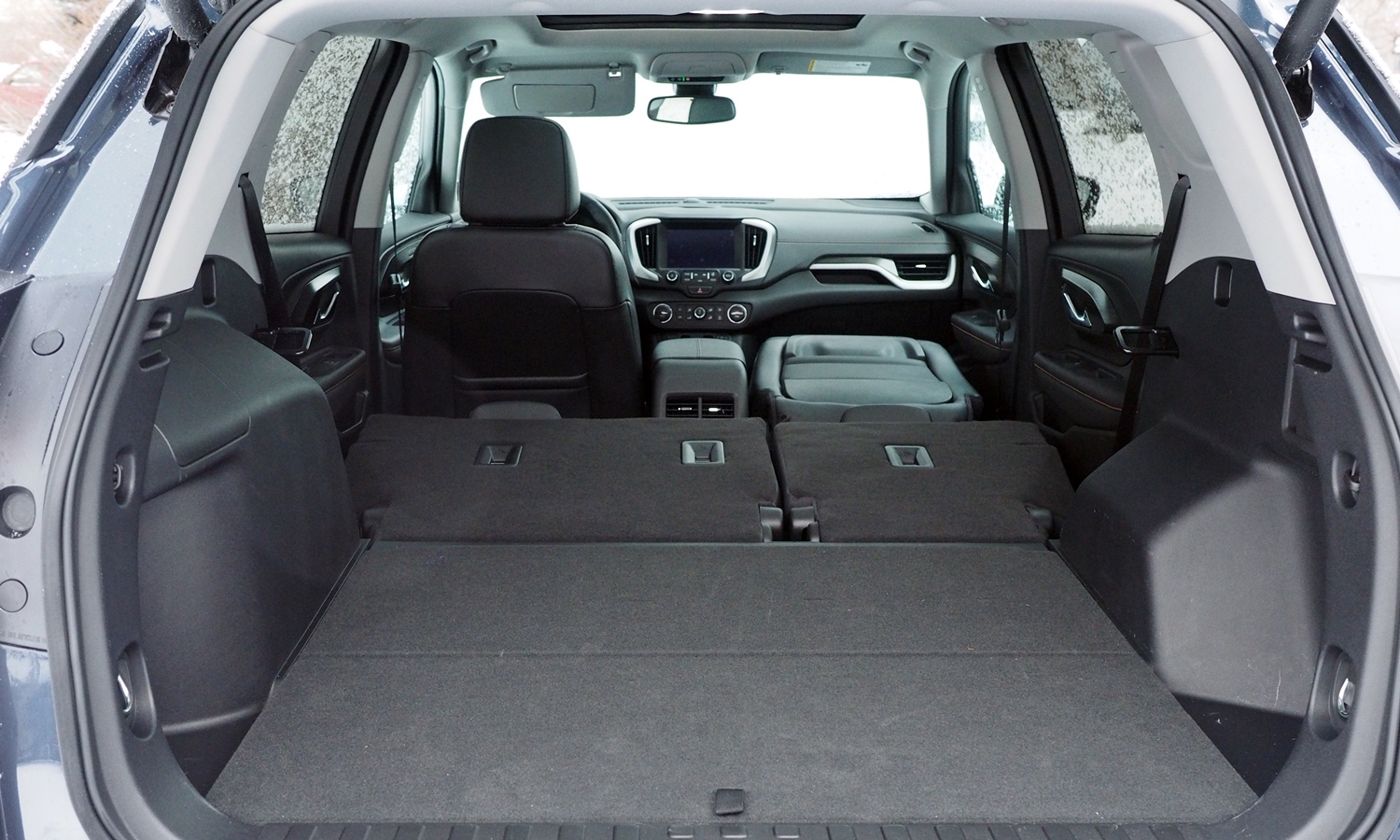
The GMC compensates for merely average cargo capacity with a folding front passenger seat.
See more 2018 GMC Terrain photos
GMC provide an insured vehicle for a week with a tank of fuel. Ross Coppersmith of Shuman Jeep in Walled Lake, MI, (248-669-2010) provided a Compass for a test drive. Lawrence Dixon of Szott Toyota in Waterford, MI, (248-525-0004) provided a RAV4 hybrid.











